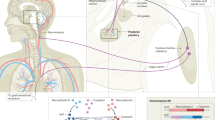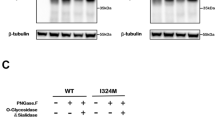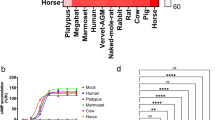Abstract
Autosomal dominant familial neurohypophyseal diabetes insipidus (adFNDI) is caused by postnatal arginine vasopressin (AVP) deficiency resulting from mutations in the AVP gene encoding the AVP pre-prohormone. To advance the understanding of adFNDI further, we have searched for mutations in the AVP gene in 15 unrelated kindreds in which diabetes insipidus appeared to be segregating. In nine kindreds, seven different previously described mutations were identified. In each of the other six kindreds, unique novel mutations were identified. Two of these (225A>G and 227G>A) change a nucleotide in the translation initiation codon of the signal peptide, whereas the other four (1797T>C, 1884G>A, 1907T>G, and 2112C>G) predict amino-acid substitutions in the neurophysin II moiety of the AVP prohormone, namely V67A (NP36), G96D (NP65), C104G (NP73), and C116W (NP85). Among these, the mutation predicting the V67A (NP36) substitution is remarkable. It affects a region of the neurophysin II not affected by any other mutations, produces only a minor change, and its inheritance suggests an incomplete penetrance. Our findings both confirm and further extend the mutation pattern that has emerged in adFNDI, suggesting that the mutations affect amino-acid residues known or reasonably presumed to be important for the proper folding and/or dimerization of the neurophysin II moiety of the AVP prohormone.
Similar content being viewed by others
Log in or create a free account to read this content
Gain free access to this article, as well as selected content from this journal and more on nature.com
or
References
Hansen LK, Rittig S, Robertson GL : Genetic basis of familial neurohypophyseal diabetes insipidus. Trends Endocrinol Metab 1997; 8: 363–372.
Robertson GL : Diabetes insipidus. Endocrinol Metab Clin North Am 1995; 24: 549–572.
McLeod JF, Kovacs L, Gaskill MB, Rittig S, Bradley GS, Robertson GL : Familial neurohypophyseal diabetes insipidus associated with a signal peptide mutation (see comments). J Clin Endocrinol Metab 1993; 77: 599A–599G.
Mahoney CP, Weinberger E, Bryant C, Ito M, Jameson JL, Ito M : Effects of aging on vasopressin production in a kindred with autosomal dominant neurohypophyseal diabetes insipidus due to the DeltaE47 neurophysin mutation. J Clin Endocrinol Metab 2002; 87: 870–876.
Green JR, Buchan GC, Alvord ECJ, Swanson AG : Hereditary and idiopathic types of diabetes insipidus. Brain 1967; 90: 707–714.
Braverman LE, Mancini JP, McGoldrick DM : Hereditary idiopathic diabetes insipidus. A case report with autopsy findings. Ann Intern Med 1965; 63: 503–508.
Bergeron C, Kovacs K, Ezrin C, Mizzen C : Hereditary diabetes insipidus: an immunohistochemical study of the hypothalamus and pituitary gland. Acta Neuropathol 1991; 81: 345–348.
van den Akker EL, de Groot MR, Abbes AP, Bruggeman EJ, Franken AA, Engel H : Identification of a new mutation (CysII6Gly) in a family with neurogenic diabetes insipidus. Ned Tijdschr Geneeskd 2000; 144: 941–945.
Goking NQ, Chertow BS, Robertson GL, Rittig S, Siggaard C, Pedersen EB : A novel AVP-neurophysin gene mutation in familial neurohypophyseal diabetes insipidus presenting with nocturnal enuresis. J Endocr Genet 2001; 2: 105–113.
Bullmann C, Kotzka J, Grimm T et al: Identification of a novel mutation in the arginine vasopressin–neurophysin II gene in familial central diabetes insipidus. Exp Clin Endocrinol Diabetes 2002; 110: 134–137.
Kanemitsu N, Kawauchi A, Nishida M et al: Familial central diabetes insipidus detected by nocturnal enuresis. Pediatr Nephrol 2002; 17: 1063–1065.
Rittig S, Siggaard C, Ozata M et al: Autosomal dominant neurohypophyseal diabetes insipidus due to substitution of histidine for tyrosine(2) in the vasopressin moiety of the hormone precursor. J Clin Endocrinol Metab 2002; 87: 3351–3355.
Rutishauser J, Kopp P, Gaskill MB, Kotlar TJ, Robertson GL : Clinical and molecular analysis of three families with autosomal dominant neurohypophyseal diabetes insipidus associated with a novel and recurrent mutations in the vasopressin–neurophysin II gene. Eur J Endocrinol 2002; 146: 649–656.
Santiprabhob J, Browning J, Repaske D : A missense mutation encoding Cys73Phe in neurophysin II is associated with autosomal dominant neurohypophyseal diabetes insipidus. Mol Genet Metab 2002; 77: 112–118.
Boson WL, Sarubi JC, D'Alva CB et al: A signal peptide mutation of the arginine vasopressin gene in monozygotic twins. Clin Endocrinol (Oxf) 2003; 58: 108–110.
Sausville E, Carney D, Battey J : The human vasopressin gene is linked to the oxytocin gene and is selectively expressed in a cultured lung cancer cell line. J Biol Chem 1985; 260: 10236–10241.
Rittig S, Robertson GL, Siggaard C et al: Identification of 13 new mutations in the vasopressin–neurophysin II gene in 17 kindreds with familial autosomal dominant neurohypophyseal diabetes insipidus. Am J Hum Genet 1996; 58: 107–117.
Eubanks S, Nguyen TL, Deeb R, Villafania A, Alfadhli A, Breslow E : Effects of diabetes insipidus mutations on neurophysin folding and function. J Biol Chem 2001; 276: 29671–29680.
Hammond C, Helenius A : Quality control in the secretory pathway: retention of a misfolded viral membrane glycoprotein involves cycling between the ER, intermediate compartment, and Golgi apparatus. J Cell Biol 1994; 126: 41–52.
Trombetta ES, Helenius A : Lectins as chaperones in glycoprotein folding. Curr Opin Struct Biol 1998; 8: 587–592.
Ellgaard L, Molinari M, Helenius A : Setting the standards: quality control in the secretory pathway. Science 1999; 286: 1882–1888.
Robertson GL, Rittig S, Gu WX et al: Pathogenesis and pathophysiology of familial neurohypophyseal diabetes insipidus; in Saito T, Kurokawa K, Yoshida S (eds): Neurohypophysis: recent progress of vasopressin and oxytocin research. Amsterdam: Elsevier Science B.V., 1995, pp 593–603.
Ito M, Jameson JL : Molecular basis of autosomal dominant neurohypophyseal diabetes insipidus. Cellular toxicity caused by the accumulation of mutant vasopressin precursors within the endoplasmic reticulum. J Clin Invest 1997; 99: 1897–1905.
Olias G, Richter D, Schmale H : Heterologous expression of human vasopressin–neurophysin precursors in a pituitary cell line: defective transport of a mutant protein from patients with familial diabetes insipidus. DNA Cell Biol 1996; 15: 929–935.
Beuret N, Rutishauser J, Bider MD, Spiess M : Mechanism of endoplasmic reticulum retention of mutant vasopressin precursor caused by a signal peptide truncation associated with diabetes insipidus. J Biol Chem 1999; 274: 18965–18972.
Nijenhuis M, Zalm R, Burbach JP : Mutations in the vasopressin prohormone involved in diabetes insipidus impair endoplasmic reticulum export but not sorting. J Biol Chem 1999; 274: 21200–21208.
Siggaard C, Rittig S, Corydon TJ et al: Clinical and molecular evidence of abnormal processing and trafficking of the vasopressin preprohormone in a large kindred with familial neurohypophyseal diabetes insipidus due to a signal peptide mutation. J Clin Endocrinol Metab 1999; 84: 2933–2941.
Nijenhuis M, Zalm R, Burbach JP : A diabetes insipidus vasopressin prohormone altered outside the central core of neurophysin accumulates in the endoplasmic reticulum. Mol Cell Endocrinol 2000; 167: 55–67.
Si-Hoe S, de Bree FM, Nijenhuis M et al: Endoplasmic reticulum derangement in hypothalamic neurons of rats expressing a familial neurohypophyseal diabetes insipidus mutant vasopressin transgene. FASEB J 2000; 14: 1680–1684.
Nijenhuis M, van den Akker EL, Zalm R et al: Familial neurohypophysial diabetes insipidus in a large Dutch kindred: effect of the onset of diabetes on growth in children and cell biological defects of the mutant vasopressin prohormone. J Clin Endocrinol Metab 2001; 86: 3410–3420.
Davies J, Murphy D : Autophagy in hypothalamic neurones of rats expressing a familial neurohypophysial diabetes insipidus transgene. J Neuroendocrinol 2002; 14: 629–637.
Yuasa H, Ito M, Nagasaki H et al: Glu-47, which forms a salt bridge between neurophysin-II and arginine vasopressin, is deleted in patients with familial central diabetes insipidus (see comments). J Clin Endocrinol Metab 1993; 77: 600–604.
Ito M, Oiso Y, Murase T et al: Possible involvement of inefficient cleavage of preprovasopressin by signal peptidase as a cause for familial central diabetes insipidus. J Clin Invest 1993; 91: 2565–2571.
Rittig S, Kovacs L, Gregersen N, Robertson GL : Familial neurogenic diabetes insipidus in 5 Danish kindreds; in Gross P, Richter D, Robertson GL (eds): Vasopressin. Paris: John Libbey Eurotext, 1993, pp 600.
Repaske DR, Summar ML, Krishnamani MR et al.: Recurrent mutations in the vasopressin–neurophysin II gene cause autosomal dominant neurohypophyseal diabetes insipidus. J Clin Endocrinol Metab 1996; 81: 2328–2334.
Calvo B, Bilbao JR, Urrutia I, Eizaguirre J, Gaztambide S, Castano L : Identification of a novel nonsense mutation and a missense substitution in the vasopressin–neurophysin II gene in two Spanish kindreds with familial neurohypophyseal diabetes insipidus. J Clin Endocrinol Metab 1998; 83: 995–997.
Repaske DR, Medlej R, Gultekin EK et al: Heterogeneity in clinical manifestation of autosomal dominant neurohypophyseal diabetes insipidus caused by a mutation encoding Ala-1 → Val in the signal peptide of the arginine vasopressin/neurophysin II/copeptin precursor. J Clin Endocrinol Metab 1997; 82: 51–56.
Heppner C, Kotzka J, Bullmann C, Krone W, Muller-Wieland D : Identification of mutations of the arginine vasopressin–neurophysin II gene in two kindreds with familial central diabetes insipidus. J Clin Endocrinol Metab 1998; 83: 693–696.
Mundschenk J, Rittig S, Siggaard C, Hensen J, Lehnert H : A new mutation of the arginine vasopressin–neurophysin II gene in a family with autosomal dominant neurohypophyseal diabetes insipidus. Exp Clin Endocrinol Diabetes 2001; 109: 406–409.
Ito M, Mori Y, Oiso Y, Saito H : A single base substitution in the coding region for neurophysin II associated with familial central diabetes insipidus. J Clin Invest 1991; 87: 725–728.
Chen LQ, Rose JP, Breslow E et al: Crystal structure of a bovine neurophysin II dipeptide complex at 2.8 A determined from the single-wavelength anomalous scattering signal of an incorporated iodine atom. Proc Natl Acad Sci USA 1991; 88: 4240–4244.
Rutishauser J, Boni-Schnetzler M, Boni J et al: A novel point mutation in the translation initiation codon of the pre- pro-vasopressin–neurophysin II gene: cosegregation with morphological abnormalities and clinical symptoms in autosomal dominant neurohypophyseal diabetes insipidus. J Clin Endocrinol Metab 1996; 81: 192–198.
Nicolas P, Batelier G, Rholam M, Cohen P : Bovine neurophysin dimerization and neurohypophyseal hormone binding. Biochemistry 1980; 19: 3565–3573.
Kanmera T, Chaiken IM : Molecular properties of the oxytocin/bovine neurophysin biosynthetic precursor. Studies using a semisynthetic precursor. J Biol Chem 1985; 260: 8474–8482.
Breslow E, Burman S : Molecular, thermodynamic, and biological aspects of recognition and function in neurophysin-hormone systems: a model system for the analysis of protein-peptide interactions. Adv Enzymol Relat Areas Mol Biol 1990; 63: 1–67.
Rose JP, Wu CK, Hsiao CD, Breslow E, Wang BC : Crystal structure of the neurophysin–oxytocin complex. Nat Struct Biol 1996; 3: 163–169.
de Bree FM, Burbach JP : Structure–function relationships of the vasopressin prohormone domains. Cell Mol Neurobiol 1998; 18: 173–191.
Kim PS, Arvan P : Endocrinopathies in the family of endoplasmic reticulum (ER) storage diseases: disorders of protein trafficking and the role of ER molecular chaperones. Endocr Rev 1998; 19: 173–202.
von Heijne G : The signal peptide. J Membr Biol 1990; 115: 195–201.
Rauch F, Lenzner C, Nurnberg P, Frommel C, Vetter U : A novel mutation in the coding region for neurophysin-II is associated with autosomal dominant neurohypophyseal diabetes insipidus. Clin Endocrinol (Oxf) 1996; 44: 45–51.
Ueta Y, Taniguchi S, Yoshida A et al: A new type of familial central diabetes insipidus caused by a single base substitution in the neurophysin II coding region of the vasopressin gene. J Clin Endocrinol Metab 1996; 81: 1787–1790.
Kubota T, Yamamoto T, Ozono K, Shimotsuji T : Hyperintensity of posterior pituitary on MR T1WI in a boy with central diabetes insipidus caused by missense mutation of neurophysin II gene. Endocr J 2001; 48: 459–463.
Abbes AP, Bruggeman B, van den Akker EL et al: Identification of two distinct mutations at the same nucleotide position, concomitantly with a novel polymorphism in the vasopressin–neurophysin II gene (AVP–NP II) in two Dutch families with familial neurohypophyseal diabetes insipidus. Clin Chem 2000; 46: 1699–1702.
Breslow E : Structure and folding properties of neurophysin and its peptide complexes: biological implications. Regul Pept 1993; 45: 15–19.
Antonarakis SE : Recommendations for a nomenclature system for human gene mutations. Nomenclature Working Group. Hum Mutat 1998; 11: 1–3.
den Dunnen JT, Antonarakis SE : Mutation nomenclature extensions and suggestions to describe complex mutations: a discussion. Hum Mutat 2000; 15: 7–12.
Willcutts MD, Felner E, White PC : Autosomal recessive familial neurohypophyseal diabetes insipidus with continued secretion of mutant weakly active vasopressin. Hum Mol Genet 1999; 8: 1303–1307.
Acknowledgements
We thank the following persons sincerely for their contribution to the study: Norbert Albers, Zentrum für Kinderheilkunde der Universität Bonn, Bonn; Michael Croxson, Auckland Hospital, Auckland; Cordula Gamm, Altonaer Kinderkrankenhaus, Hamburg; Václav Hána, Charles University, Prague; Gert Matthijs, Katholieke Universiteit Leuven, Leuven; Patrizia Matarazzo, University of Torino, Torino; K Sinko-Sanz, Universitätsklinik für Kinder- und Jugendheilkunde, Vienna; Dag Veimo, Nordland Sentralsykehus, Bodø; Franz Waldhauser, Universitätsklinik für Kinder- und Jugendheilkunde, Vienna; and Otto Westphal, Barn och Ungdoms Sjukhus, Göteborg. Last but not the least, we also thank Jane Hagelskjær Knudsen for her skilled laboratory assistance. This work was supported by grants from the Novo Nordic Foundation and the University of Aarhus, Denmark.
Author information
Authors and Affiliations
Corresponding author
Rights and permissions
About this article
Cite this article
Christensen, J., Siggaard, C., Corydon, T. et al. Six novel mutations in the arginine vasopressin gene in 15 kindreds with autosomal dominant familial neurohypophyseal diabetes insipidus give further insight into the pathogenesis. Eur J Hum Genet 12, 44–51 (2004). https://doi.org/10.1038/sj.ejhg.5201086
Received:
Revised:
Accepted:
Published:
Issue date:
DOI: https://doi.org/10.1038/sj.ejhg.5201086
Keywords
This article is cited by
-
Comparison of ELISA and RIA methods to quantify arginine vasopressin hormone levels in cell culture
Biologia (2022)
-
Functional analyses of three different mutations in the AVP-NPII gene causing familial neurohypophyseal diabetes insipidus
Endocrine (2021)
-
Autosomal dominant familial neurohypophyseal diabetes insipidus caused by a novel missense mutation in AVP gene in a large Italian kindred
Endocrine (2021)
-
Familial neurohypophyseal diabetes insipidus: clinical, genetic and functional studies of novel mutations in the arginine vasopressin gene
Pituitary (2021)
-
A novel AVP gene mutation in a Turkish family with neurohypophyseal diabetes insipidus
Journal of Endocrinological Investigation (2016)



